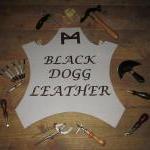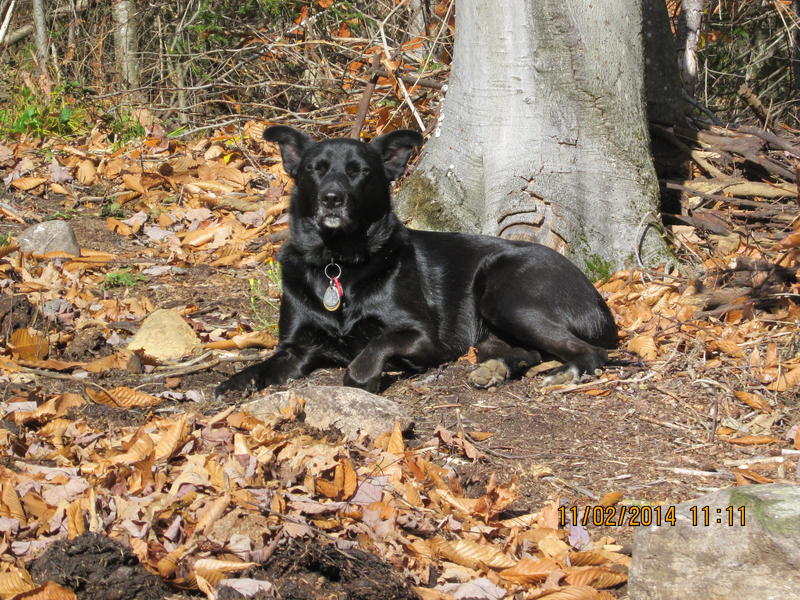-
Posts
111 -
Joined
-
Last visited
Content Type
Profiles
Forums
Events
Blogs
Gallery
Everything posted by Black Dogg
-

How To Machine Sew A Buckle And Dee To A Collar?
Black Dogg replied to lightingale's topic in Sewing Leather
Lightingale, check out this thread: http://leatherworker.net/forum/index.php?showtopic=51729&hl=%2Bcopper+%2Brivet+%2Bjig I bought one of these jigs and they are great! Takes a bit of practice for consistent Rivets, but you save some money over the ready-made ones and you can make them the exact length you need. Black Dogg -

Trouble Peening Copper Rivets
Black Dogg replied to Leslie Ryanne's topic in Hardware and Accessories
I second Chief's method of riveting; simple and does the job very well The tool that aconstruction makes is well worth buying. You can make your own rivets in no time and save some money, too. It's solid and should last forever!- 20 replies
-
- copper rivets
- peening
-
(and 1 more)
Tagged with:
-
Troy, If I recall correctly, Stohlman's book "The Art of Making Leather Cases Vol. 1" covers this topic in the section on sewing tubular cases(like the thermos cover). Don't have the book here with me, so I can't check, but I think that's where I got it from. Whenever possible I do it like the last paragraph in the PDF file that gary posted. The holes tend to get a bit large if you go through them more than once.
-
Jimbob, you must have lived really close to where I'm from. Around Ulm we used to say "Wia gad's dr?" or "Griass Godd". And yes, Schwaebisch is the REAL German language!!
-
Oh wow.... did I ever open a can of worms here . I apologize for hijacking your welcome thread, Wynfrith. Sona, while I lived in Germany until I was 19, I never really travelled much farhter north than Stuttgart, so I guess I was kind of overgeneralizing. I think it was Mark Twain who said "It's better to be quiet and have people assume you're a fool, than to open your mouth and assure them of it." That would apply to my post above. On the other hand I learned something new again , never too late for that!
-
Hi Erystawi, I have made a few different sizes of dog packs for both my own and a few friends. You can make them as easy or complicated as you wish. Mine pretty much were modelled after horse packs; the kind that go behind the saddle. I also padded the piece that goes across the back with some sheepskin to make it more comfortable. A few tips on "packing" your dogs: Make sure the load is balanced or your four-legger will look and walk like potbelly pig in no time. Pad the inside of the bags (the one against the dog's side) with something soft, like a folded washcloth, if you're putting any thing hard (like bicuits) in the pack. According to my vet, a healthy dog can carry about a third of its body weight in a pack ( i.e. a sixty pound dog could carry about twenty pounds) although I like to keep the load to about a quarter of the dog's weight, just in case. Have fun ! Black Dogg
-
Hey Sona, "Gruess Gott" is actually not bavarian slang (although used there a lot), it's "Hochdeutsch" (high German) for "Greet the Lord". In Bavaria you usually say "Grias Di" ("Greetings to you") or "Servus" ( kinda like "Hi"). Just thought I'd set the record straight . I know 'cause I grew up just on the other side of the Bavarian border . Nonetheless, I was fooled, too, when I saw the title. Lastly, welcome Wynfrith! Black Dogg
-

Adler Class Iii - Early 1900 Leather Sewing Machine
Black Dogg replied to Constabulary's topic in Leather Sewing Machines
For needles you might try calling Campbell-Randall over here in the US. They have all kinds of needles, even odd and old sizes. Their Customer service is second to none!! If calling is too expensive, shoot them an email, I'm pretty sure they can help you. They found the right needle for my old Duerkopp patcher in a lot of mixed, old stuff in their warehouse after I talked to a nice lady on the phone! Good luck with your project; it's looking good already! -
Nice piece of work, indeed, for a newbie! Looks a lot better than my first try ! I know the feeling when you're waiting for some new toys; just wait until the package gets there Have fun and welcome to the forum!
-
Chekkarn, A word of advice on the right side strap, if I may: Stitching across the entire strap behind a buckle or D-ring like that will weaken the leather considerably. I call it the "postage stamp effect". It basically creates a perforation right along the major stress axis. On a watch strap this isn't going to matter too much, but if you ever do any kind of strap work that sees heavy use (horse gear, belts, purse straps, etc.) it is much better to sew for a short distance ( 1-2 inches, depending on the width and thickness of the leather used) along both sides. This will make a much stronger joint. Good luck and welcome to the forum! Black Dogg
-
For round, welded rings and some sizes of d-rings the hardware section at Lowe's or Home Depot is a good place to look. Another option would be your local hardware store. Buckles I would still order through the mail, unless there's a tack shop nearby where you can get them. Happy hunting!
-
I received my jig last week and just thought I'd give a short review for any one thinking about buying one: The jig itself is very well made; it looks exactly like in the pics. I think it's pretty well indestructible and should last a lifetime and then some when used as directed. The instructions that come with it are clear and easy to follow. I found it worked best if I laid the whole jig on my anvil in the shop, but the flat back piece of a vise should work as well. It took three tries to get the hang of it, but now I can make a rivet in less than a minute. Delivery was fast; I placed my order on Wednesday afternoon and the package arrived on Saturday. All in all a great product at a great price!! Black Dogg
-
Could not have said it better, Camano Ridge! One thing I don't quite like about the overstitch wheel you linked to is the fact that the screw has a tendency to come loose on long lines if not really tight. The little screwdriver that comes with the set is a bit wimpy for my taste. I have upgraded to single (fixed) wheel overstitchers a couple of years ago but still use this one in my travelling toolbox. Nonetheless a good beginner setup!
-
Not surprising at this price!
-

A Couple Of Dog Collars
Black Dogg replied to pearlheartgtr's topic in Collars, Cuffs, Leashes and Leads
Very nicely done!! May I ask what kind of closure you used? In one pic it looks like a roller buckle but I'm not sure. Also, what thickness leather? I normally use two layers of 3-4oz. stitched back-to-back or 7-8oz. for single layer collars. Black Dogg -
Agree with all you folks!!
-
Greetings Martin, first off great job on the restoration!! I love the old tools and if somone gives them a second life that's even better! The letters DRGM are not the maker's brand or name but are initials that stand for "Deutsches Reichsgebrauchsmuster". This was used since the late 1800's to denote that the particular design of a tool or machine was registered in all of Germany; sort of like a patent. I'll copy a better explanation I found on the website porcelainmarksandmore.com below: The acronym D.R.G.M. with or without punctuation stands for Deutsches Reichsgebrauchsmuster, meaning that the design or function of an item was officially registered inside all of the Germany states and not only locally registered as it was the case before the introduction of centralized registration. Note that many people quote this acronym as standing for Deutsches Reich Gebrauchsmuster, which is grammatically wrong and also ommits the letter 's' after Reich. This results in shifting the weight of pronounciation on 'Deutsches Reich' alone, but this acronym has nothing to do with the Third Reich as many sellers want to imply so to catch the attention of certain 'collectors'. D.R.G.M. registration was introduced 1891 and if you are dating items you should hold in mind that even during Allied occupation up until 1949, registration procedures remained untouched and still used the D.R.G.M. registration documents, which of course explains why D.R.G.M. marks can be found on products actually manufactured up until 1952 as the registration itself was valid for three years. As from the end of October 1952, all registrations were definately marked with 'Deutsches Bundesgebrauchsmuster' (D.B.G.M.) or simply with 'Gebrauchsmuster' or 'Gebrauchsmusterschutz', see below. As already noted, the D.R.G.M. registration offered a basic copyright protection for the duration of three years and included the right to indicate the item status by marking the registered items with the D.R.G.M. acronym. It was left to the registration owner to include the registration number as the D.R.G.M. marking alone was the element with legal character. The actual result of such a registration (the form of protection) was called Gebrauchsmusterschutz (see there for more info). D.R.G.M. registered products were protected either for their way of intended use or design only and this did not include patent protection. Patent rights were secured by applying for a Deutsches Reichspatent (D.R.P.), so even if many people use the term 'D.R.G.M-Patent' it is factually wrong. Reason for this mix-up was that the D.R.G.M. registration in colloquial language was also known as 'kleines Reichspatent' which literally stands for 'small Imperial patent' but actually was meant as 'poor people's patent' and made fun of the fact that many manufacturers could not afford the fees needed to register a full patent. One should take into count that German patent registration fees (as was openly criticized during the year 1906) where two and a half times higher than in England - and 36 (!!!) times higher than in the US. As to the maker of your gauge, you could probably try to contact some museums to see if they could help you find out more. Hope this helps! Black Dogg
-
Hi Viv, It's hard to ID any kind of leather from just a picture, however, in the pics above I'd say that a thin veg tan leather was used, probably 2-3 or 3-4oz. thickness. The interior parts in the second pic look like the leather was left natural, maybe a coat of neatsfoot oil or something like it. All of the outside pics definitely are dyed leather if veg tan was used. Some leathers are dyed during the tanning process (the dye goes all the way thruogh the piece, not just on the grain side), but those are usually the browns and blacks for saddle and motorcycle accessoiries; I haven't seen any really bright colors like in your last pic done that way. Hope this helps! Black Dogg
-
Got my old Duerkopp 18-1 all cleaned up and running like new!!
-
Hi John, The jaws on this style of pony are indeed supposed to provide their own tension; the lever is used to open them. In the picture it looks as though yours have "relaxed" a bit over time and won't close all the way or they could have been made for heavier items. If you want to use it just put a strap around the narrow part and tighten it up that way (a ratchet type buckle would work best). Those ponies don't have a base, they were meant to be held between your thighs while you were seated on a chair. You could always mount it to a low bench if you like a fixed clamp. Hope this helps! Black Dogg
-
Hi there X4, I don't want to be too prying, but how long have you been hand sewing? I'm just asking because when I first started out I thought along the same lines as you, but once I got the hang of it I found hand sewing to be quite a bit faster, especially on some of the smaller items with a lot of details. Also, in my humble opinion, there's nothing nicer than hand sewn horse tack or a well made knife sheath. The third item I'd like to mention is that when you're sewing by hand you can ask more for it; I have found some of my customers specifically asking for that even though I told them it would cost more. That all being said, I do not want to discourage you from getting a machine. Judging by your specs you'd be well served with one of the old treadle machines. A hand cranked one can be pain if you need two hands to guide your work. Look here in the "For Sale" categorie or for "antique leather sewing machine" on e-bay or craigslist. A word of caution, though: Those oldies come in all forms, from "needs-a-little-oil-and-runs-like-a-charm" to "one-heap-of-rust-with-some-parts-thrown-in". Look at the pictures (if any) and ask lots of questions. Of course, preferably look it over in person before buying. Good Hunting! Black Dogg
-
Hi Michael, sounds like you're having a good time doing it and that's the main thing!! On your second item: It took me a good year to learn all the fine points (no pun intended) of tool sharpening, mostly from Al Stohlman's books and some friendly advice from an old cobbler in town. I learned also that it's a lot easier to strop than to sharpen. When I carve I have my strop right next to me on the bench and about every ten minutes I just do a few quick swipes across with the swivel knife. Keeps the blade nice and sharp and takes hardly any time at all; same thing with the awl. I made my strop by simply glueing a piece of leather (about 4"x20") to a board flesh side up and loading it with green polishing compound. The white stuff Tandy sells didn't work too well, so I got some green from a wood tool supplier. Hope this helps! Black Dogg
-
Gentlemen, thank you for the praise, but I merely posted the link here. All credit is due to Mr. Bethke and his website, I just happened upon it while looking. Steve, if you would please email him (he has contact info on the website) and let him know about the other manuals you have. I'm sure he'll gladly include them. Also, in regards to the Randall and Campbell-Bosworth manuals, have you tried to contact the company? They are now called Campbell-Randall (www.campbell-randall.com) and their customer service reps are one of the friendliest people I've ever talked to. They were the folks who helped me find the right needles for my Duerkopp. Ralph, you're right about everyone contributing to the forum; it would be sort of a clearinghouse for manuals that would help a lot of collectors and restorers. You can also leave a note on Mr. Bethke's visitor log, just click on "Gaestebuch". Black Dogg
-
If you have an old shoe patcher and you are looking for the manual give this link a try: www.altenaehmaschine.de . Click on "Bedienungsanleitungen" and it will show on the left side which ones are there to view; currently there's Adler Class 30, Singer 29K, Duerkopp and Claes. Yes, the site is in German, as are the Manuals, but even if you can't read them or find an old Kraut like me to translate them for you the pictures can sometimes help you out just by themselves. I had been looking for a manual for my Duerkopp 18-1 and finally found it there. The Owner of the site, Mr. Lars Bethke, has a shop that specializes in fixing and restoring old patchers and even sells some parts online. Also, there are a few nice pictures of "Works-in-progress" and fully restored machines. He is also looking for other manuals that might still be out there so he can put them up on his website for everyone to see. Enjoy! Black Dogg
-
Sieht echt klasse aus, die Klemme!! Ich habe mir eine nach dem Plan in Al Stohlman's Art of Handsewing Leather Buch gebaut. Deine ist allerdings wesentlich schoener! Black Dogg (ein ehemaliger Deutscher, seit etlichen Jahren in den USA)



